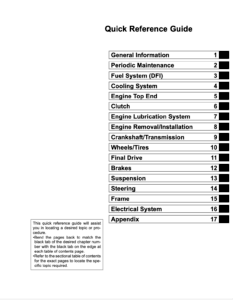Complete PDF version of the Service Manual for the Kawasaki Versys 650 Mk1. A MUST for every Versys 650 owner.
Download: Immediately after payment!
OEM Original factory workshop manual.
Models covered by this manual: 2007 to 2009
Number of pages: 627 pages
Table of contents:

This PDF repair manual can be downloaded right after the payment process in complete, on the device of your choice.
We do not offer printed manuals, for the following reasons:
- it is more eco-friendly to use a digital version
- your manual never gets dirty or greasy
- you can always choose to print the specific page(s) you need to work on your bike
- you receive your manual immediately after payment
- it is searchable
Kawasaki Versys 650
The Kawasaki Versys 650 (KLE650) is a mid-size motorbike. It borrows design features from dual-sport bikes, ordinary bikes, adventure tourers, and sport bikes, sharing qualities from all of them but not cleanly fitting into any of them. Versys is a combination of the terms versatile and system. Kawasaki debuted it as a 2007 model in the European and Canadian markets, and as a 2008 model in the US market. In 2009, a California emissions-compliant variant was introduced. In 2010, the headlights and farings received new design, as well as various functional upgrades such as bigger mirrors and enhanced rubber engine mounts. In 2015, a new model was released with a new fairing type that replaced the earlier, stacked headlamps with the more traditional twin headlight layout found on sportbikes.
The Versys rides on the same chassis as Kawasaki’s two 650cc twins, the Ninja 650R and the ER-6n. Its siblings share the same electronics, motor, wheels, brakes, and main frame. The riding posture, rear subframe, suspension components, and engine tune are where it varies.
The Versys’ 650 cc liquid-cooled, four-stroke parallel-twin engine has been retuned for improved low- and mid-range torque. This is accomplished through the use of variable camshafts and fuel injection settings. These modifications cause peak torque to occur at a lower engine speed and improve throttle responsiveness between 3,000 and 6,000 rpm. A balancing tube has also been installed between the exhaust headers to level out power delivery. Power is 68 hp (51 kW) at 8,500 rpm, compared with the Ninja’s 67 hp (50 kW) at 8,000 rpm. Torque is 47.2 lbft (64.0 Nm) versus the Ninja’s 48.45 lbft (65.69 Nm). However, improving the engine’s low and mid-range responsiveness comes at the price of a little decrease in peak output.
Honda recently used a same strategy with its CBF1000 model. The engine has a crankshaft that rotates 180 degrees. This necessitates an irregular firing interval (180 degrees, 540 degrees), which results in a characteristic “throbbing” sound at idle.
The suspension offers more vertical travel and adjustability than the Versys 650 brothers’ suspensions. Externally adjustable preload and rebound damping are available on the front thicker/stiffer 41 mm inverted telescopic forks. The right fork leg houses a damping cartridge, while both legs are spring-loaded. The rebound damping of the rear shock absorber is adjustable. The rear suspension preload is adjustable via a screw collar on the shock. Models from 2015 and above feature an external adjustment. Instead of the more basic steel swing arm used on the Ninja and ER-6, the rear shock/spring is directly attached, without linkages, to a non-symmetrical, gull wing, aluminum swing arm.
Source: Wikipedia


